Case Study: Unilever's Consumer Engagement and Marketing Analysis
VerifiedAdded on 2023/06/12
|6
|1465
|154
Case Study
AI Summary
This case study analyzes Unilever's approach to connecting with consumers through understanding internal psychological processes and external cultural factors. It discusses how Unilever utilizes its understanding of consumer psychology to market its products, exemplified by the Dove's Campaign for Real Beauty, which leverages ethnicity to resonate with a diverse audience. The study also evaluates Unilever's decision to link its brands with healthy and sustainable behaviors, highlighting the benefits of building consumer loyalty and a positive brand image. Furthermore, it examines IKEA's marketing strategies, including the Manland experiment and its approach to targeting gay couples, considering the advantages and disadvantages of these initiatives. The analysis extends to IKEA's product suitability for different consumption patterns and its continued use of printed catalogs. Desklib offers a platform for students to access similar case studies and solved assignments.
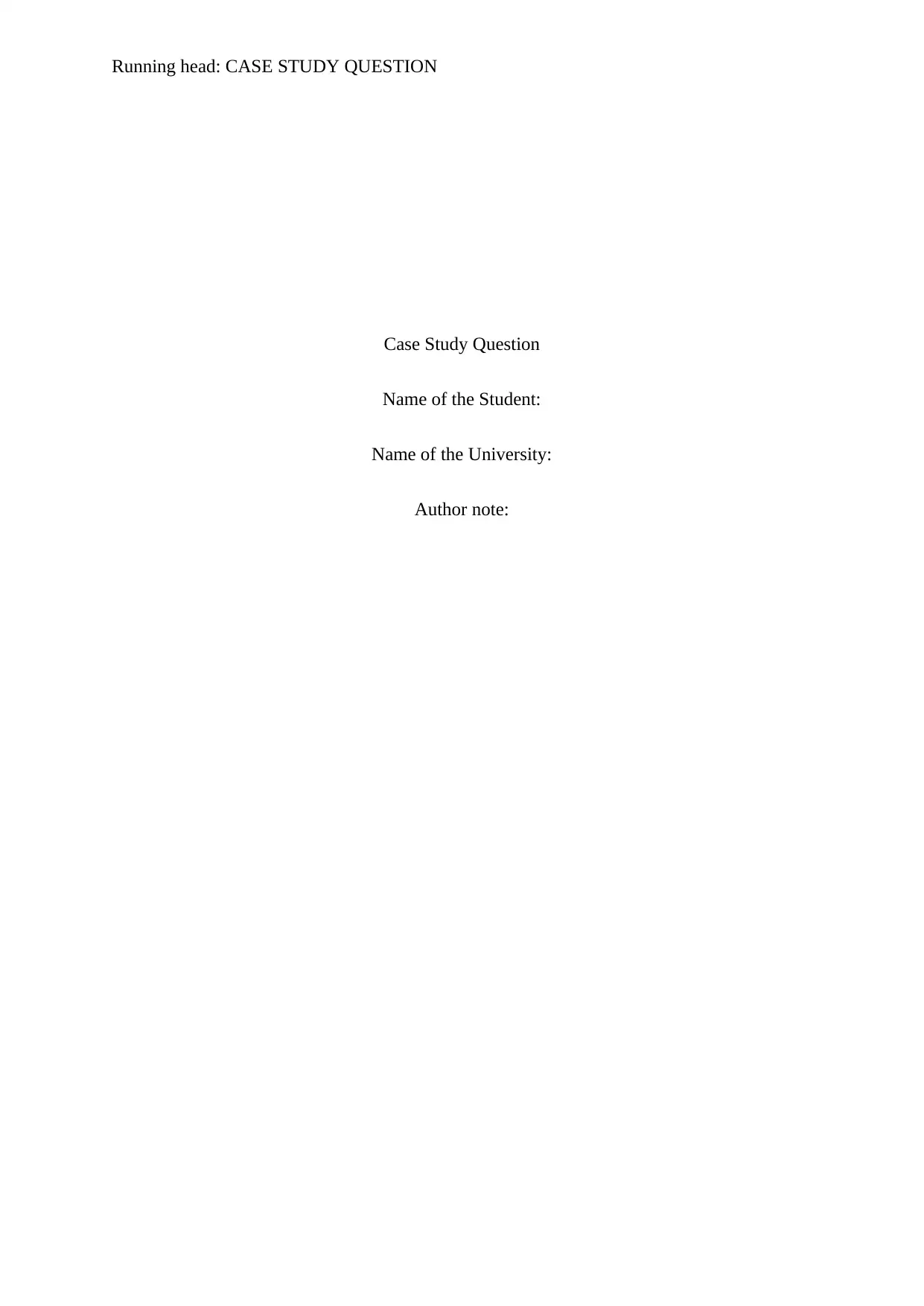
Running head: CASE STUDY QUESTION
Case Study Question
Name of the Student:
Name of the University:
Author note:
Case Study Question
Name of the Student:
Name of the University:
Author note:
Paraphrase This Document
Need a fresh take? Get an instant paraphrase of this document with our AI Paraphraser
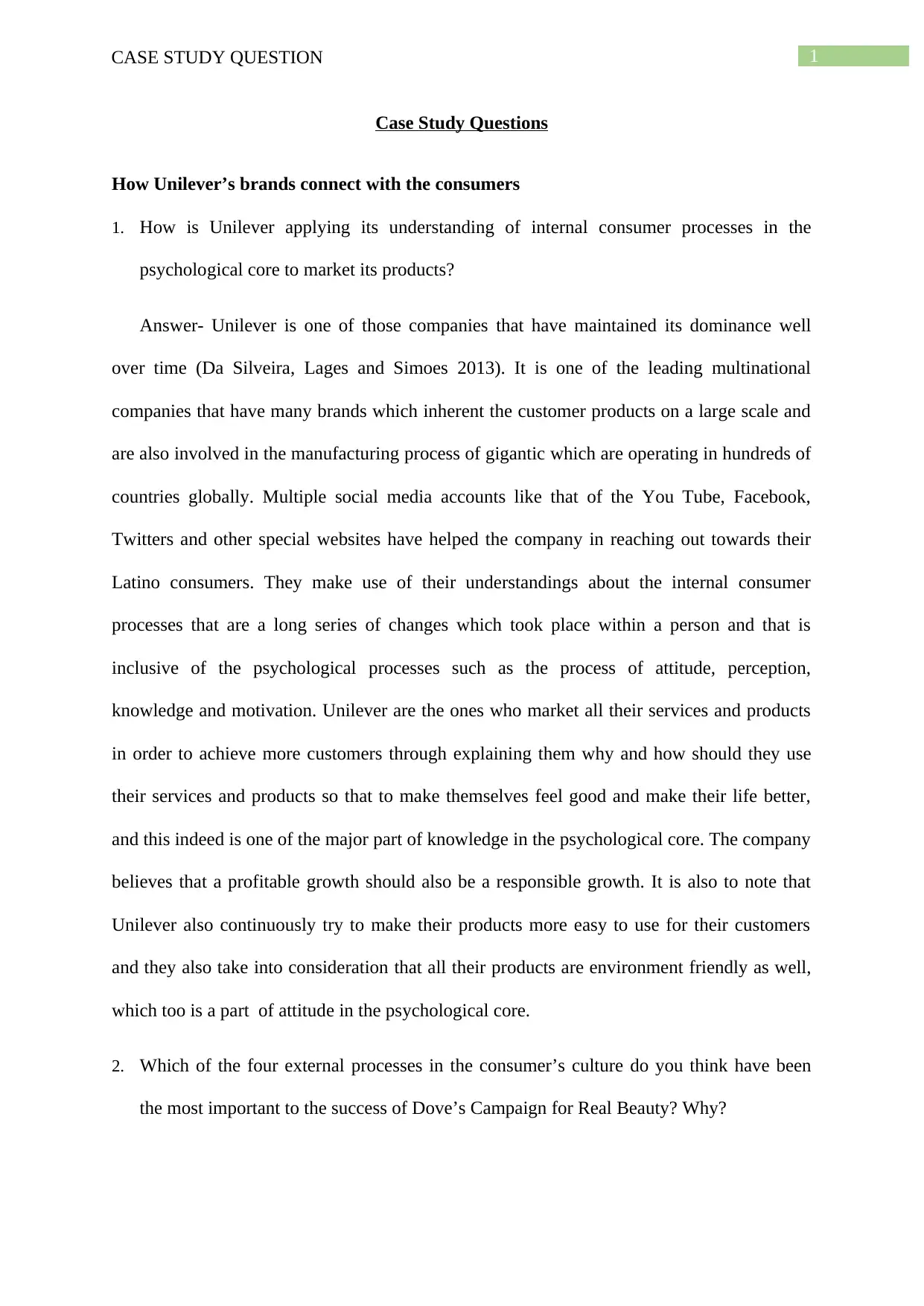
1CASE STUDY QUESTION
Case Study Questions
How Unilever’s brands connect with the consumers
1. How is Unilever applying its understanding of internal consumer processes in the
psychological core to market its products?
Answer- Unilever is one of those companies that have maintained its dominance well
over time (Da Silveira, Lages and Simoes 2013). It is one of the leading multinational
companies that have many brands which inherent the customer products on a large scale and
are also involved in the manufacturing process of gigantic which are operating in hundreds of
countries globally. Multiple social media accounts like that of the You Tube, Facebook,
Twitters and other special websites have helped the company in reaching out towards their
Latino consumers. They make use of their understandings about the internal consumer
processes that are a long series of changes which took place within a person and that is
inclusive of the psychological processes such as the process of attitude, perception,
knowledge and motivation. Unilever are the ones who market all their services and products
in order to achieve more customers through explaining them why and how should they use
their services and products so that to make themselves feel good and make their life better,
and this indeed is one of the major part of knowledge in the psychological core. The company
believes that a profitable growth should also be a responsible growth. It is also to note that
Unilever also continuously try to make their products more easy to use for their customers
and they also take into consideration that all their products are environment friendly as well,
which too is a part of attitude in the psychological core.
2. Which of the four external processes in the consumer’s culture do you think have been
the most important to the success of Dove’s Campaign for Real Beauty? Why?
Case Study Questions
How Unilever’s brands connect with the consumers
1. How is Unilever applying its understanding of internal consumer processes in the
psychological core to market its products?
Answer- Unilever is one of those companies that have maintained its dominance well
over time (Da Silveira, Lages and Simoes 2013). It is one of the leading multinational
companies that have many brands which inherent the customer products on a large scale and
are also involved in the manufacturing process of gigantic which are operating in hundreds of
countries globally. Multiple social media accounts like that of the You Tube, Facebook,
Twitters and other special websites have helped the company in reaching out towards their
Latino consumers. They make use of their understandings about the internal consumer
processes that are a long series of changes which took place within a person and that is
inclusive of the psychological processes such as the process of attitude, perception,
knowledge and motivation. Unilever are the ones who market all their services and products
in order to achieve more customers through explaining them why and how should they use
their services and products so that to make themselves feel good and make their life better,
and this indeed is one of the major part of knowledge in the psychological core. The company
believes that a profitable growth should also be a responsible growth. It is also to note that
Unilever also continuously try to make their products more easy to use for their customers
and they also take into consideration that all their products are environment friendly as well,
which too is a part of attitude in the psychological core.
2. Which of the four external processes in the consumer’s culture do you think have been
the most important to the success of Dove’s Campaign for Real Beauty? Why?
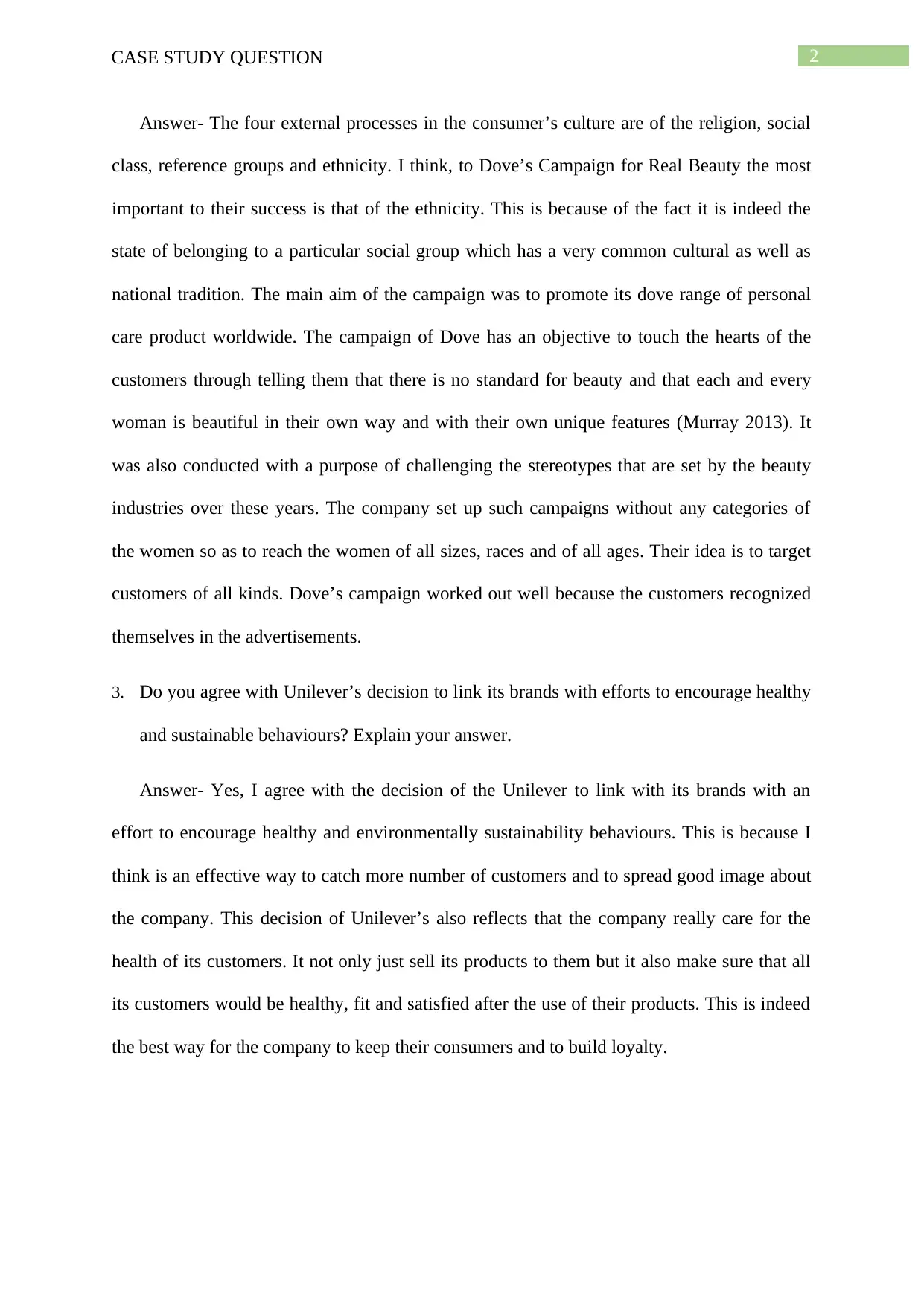
2CASE STUDY QUESTION
Answer- The four external processes in the consumer’s culture are of the religion, social
class, reference groups and ethnicity. I think, to Dove’s Campaign for Real Beauty the most
important to their success is that of the ethnicity. This is because of the fact it is indeed the
state of belonging to a particular social group which has a very common cultural as well as
national tradition. The main aim of the campaign was to promote its dove range of personal
care product worldwide. The campaign of Dove has an objective to touch the hearts of the
customers through telling them that there is no standard for beauty and that each and every
woman is beautiful in their own way and with their own unique features (Murray 2013). It
was also conducted with a purpose of challenging the stereotypes that are set by the beauty
industries over these years. The company set up such campaigns without any categories of
the women so as to reach the women of all sizes, races and of all ages. Their idea is to target
customers of all kinds. Dove’s campaign worked out well because the customers recognized
themselves in the advertisements.
3. Do you agree with Unilever’s decision to link its brands with efforts to encourage healthy
and sustainable behaviours? Explain your answer.
Answer- Yes, I agree with the decision of the Unilever to link with its brands with an
effort to encourage healthy and environmentally sustainability behaviours. This is because I
think is an effective way to catch more number of customers and to spread good image about
the company. This decision of Unilever’s also reflects that the company really care for the
health of its customers. It not only just sell its products to them but it also make sure that all
its customers would be healthy, fit and satisfied after the use of their products. This is indeed
the best way for the company to keep their consumers and to build loyalty.
Answer- The four external processes in the consumer’s culture are of the religion, social
class, reference groups and ethnicity. I think, to Dove’s Campaign for Real Beauty the most
important to their success is that of the ethnicity. This is because of the fact it is indeed the
state of belonging to a particular social group which has a very common cultural as well as
national tradition. The main aim of the campaign was to promote its dove range of personal
care product worldwide. The campaign of Dove has an objective to touch the hearts of the
customers through telling them that there is no standard for beauty and that each and every
woman is beautiful in their own way and with their own unique features (Murray 2013). It
was also conducted with a purpose of challenging the stereotypes that are set by the beauty
industries over these years. The company set up such campaigns without any categories of
the women so as to reach the women of all sizes, races and of all ages. Their idea is to target
customers of all kinds. Dove’s campaign worked out well because the customers recognized
themselves in the advertisements.
3. Do you agree with Unilever’s decision to link its brands with efforts to encourage healthy
and sustainable behaviours? Explain your answer.
Answer- Yes, I agree with the decision of the Unilever to link with its brands with an
effort to encourage healthy and environmentally sustainability behaviours. This is because I
think is an effective way to catch more number of customers and to spread good image about
the company. This decision of Unilever’s also reflects that the company really care for the
health of its customers. It not only just sell its products to them but it also make sure that all
its customers would be healthy, fit and satisfied after the use of their products. This is indeed
the best way for the company to keep their consumers and to build loyalty.
⊘ This is a preview!⊘
Do you want full access?
Subscribe today to unlock all pages.

Trusted by 1+ million students worldwide
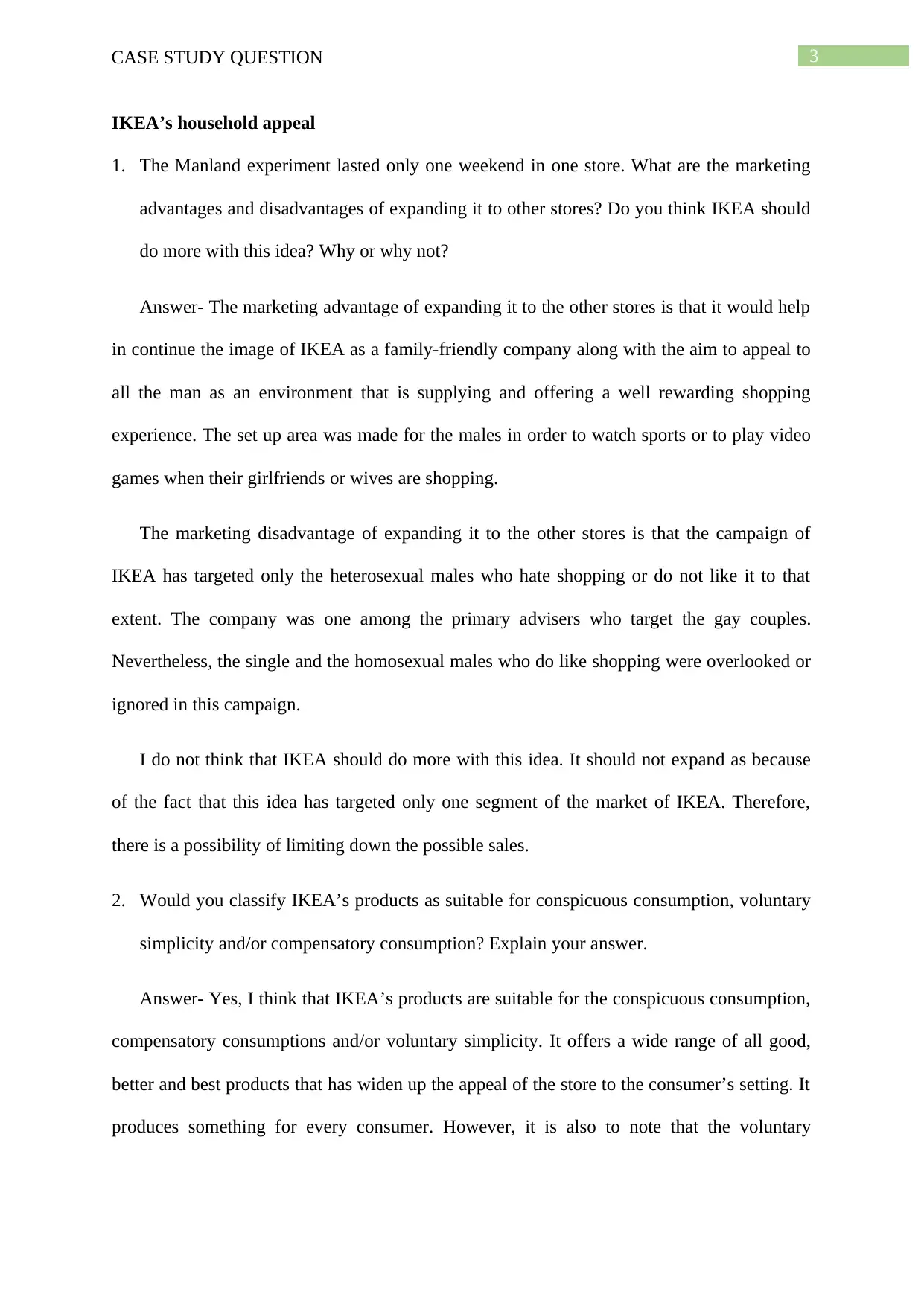
3CASE STUDY QUESTION
IKEA’s household appeal
1. The Manland experiment lasted only one weekend in one store. What are the marketing
advantages and disadvantages of expanding it to other stores? Do you think IKEA should
do more with this idea? Why or why not?
Answer- The marketing advantage of expanding it to the other stores is that it would help
in continue the image of IKEA as a family-friendly company along with the aim to appeal to
all the man as an environment that is supplying and offering a well rewarding shopping
experience. The set up area was made for the males in order to watch sports or to play video
games when their girlfriends or wives are shopping.
The marketing disadvantage of expanding it to the other stores is that the campaign of
IKEA has targeted only the heterosexual males who hate shopping or do not like it to that
extent. The company was one among the primary advisers who target the gay couples.
Nevertheless, the single and the homosexual males who do like shopping were overlooked or
ignored in this campaign.
I do not think that IKEA should do more with this idea. It should not expand as because
of the fact that this idea has targeted only one segment of the market of IKEA. Therefore,
there is a possibility of limiting down the possible sales.
2. Would you classify IKEA’s products as suitable for conspicuous consumption, voluntary
simplicity and/or compensatory consumption? Explain your answer.
Answer- Yes, I think that IKEA’s products are suitable for the conspicuous consumption,
compensatory consumptions and/or voluntary simplicity. It offers a wide range of all good,
better and best products that has widen up the appeal of the store to the consumer’s setting. It
produces something for every consumer. However, it is also to note that the voluntary
IKEA’s household appeal
1. The Manland experiment lasted only one weekend in one store. What are the marketing
advantages and disadvantages of expanding it to other stores? Do you think IKEA should
do more with this idea? Why or why not?
Answer- The marketing advantage of expanding it to the other stores is that it would help
in continue the image of IKEA as a family-friendly company along with the aim to appeal to
all the man as an environment that is supplying and offering a well rewarding shopping
experience. The set up area was made for the males in order to watch sports or to play video
games when their girlfriends or wives are shopping.
The marketing disadvantage of expanding it to the other stores is that the campaign of
IKEA has targeted only the heterosexual males who hate shopping or do not like it to that
extent. The company was one among the primary advisers who target the gay couples.
Nevertheless, the single and the homosexual males who do like shopping were overlooked or
ignored in this campaign.
I do not think that IKEA should do more with this idea. It should not expand as because
of the fact that this idea has targeted only one segment of the market of IKEA. Therefore,
there is a possibility of limiting down the possible sales.
2. Would you classify IKEA’s products as suitable for conspicuous consumption, voluntary
simplicity and/or compensatory consumption? Explain your answer.
Answer- Yes, I think that IKEA’s products are suitable for the conspicuous consumption,
compensatory consumptions and/or voluntary simplicity. It offers a wide range of all good,
better and best products that has widen up the appeal of the store to the consumer’s setting. It
produces something for every consumer. However, it is also to note that the voluntary
Paraphrase This Document
Need a fresh take? Get an instant paraphrase of this document with our AI Paraphraser
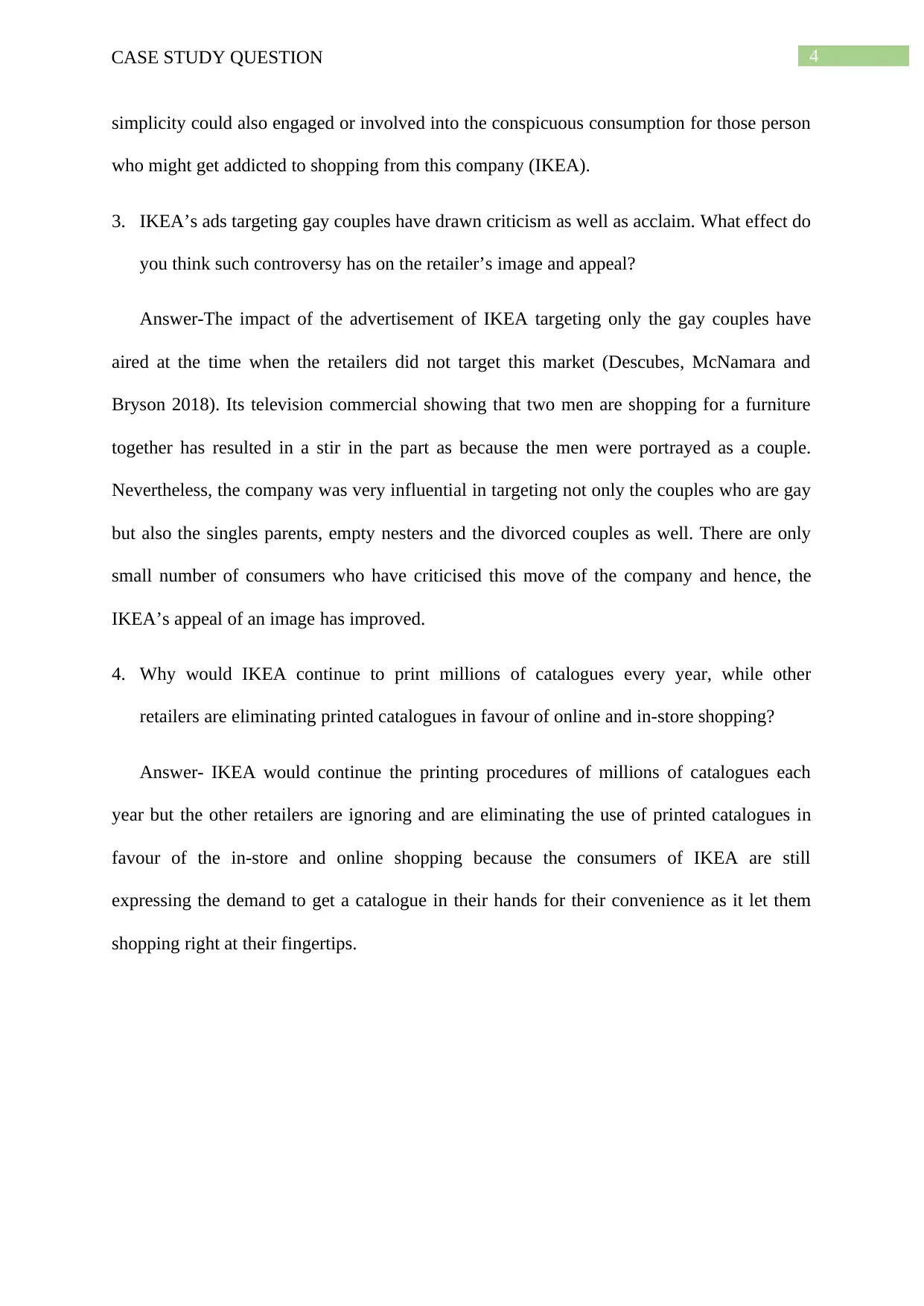
4CASE STUDY QUESTION
simplicity could also engaged or involved into the conspicuous consumption for those person
who might get addicted to shopping from this company (IKEA).
3. IKEA’s ads targeting gay couples have drawn criticism as well as acclaim. What effect do
you think such controversy has on the retailer’s image and appeal?
Answer-The impact of the advertisement of IKEA targeting only the gay couples have
aired at the time when the retailers did not target this market (Descubes, McNamara and
Bryson 2018). Its television commercial showing that two men are shopping for a furniture
together has resulted in a stir in the part as because the men were portrayed as a couple.
Nevertheless, the company was very influential in targeting not only the couples who are gay
but also the singles parents, empty nesters and the divorced couples as well. There are only
small number of consumers who have criticised this move of the company and hence, the
IKEA’s appeal of an image has improved.
4. Why would IKEA continue to print millions of catalogues every year, while other
retailers are eliminating printed catalogues in favour of online and in-store shopping?
Answer- IKEA would continue the printing procedures of millions of catalogues each
year but the other retailers are ignoring and are eliminating the use of printed catalogues in
favour of the in-store and online shopping because the consumers of IKEA are still
expressing the demand to get a catalogue in their hands for their convenience as it let them
shopping right at their fingertips.
simplicity could also engaged or involved into the conspicuous consumption for those person
who might get addicted to shopping from this company (IKEA).
3. IKEA’s ads targeting gay couples have drawn criticism as well as acclaim. What effect do
you think such controversy has on the retailer’s image and appeal?
Answer-The impact of the advertisement of IKEA targeting only the gay couples have
aired at the time when the retailers did not target this market (Descubes, McNamara and
Bryson 2018). Its television commercial showing that two men are shopping for a furniture
together has resulted in a stir in the part as because the men were portrayed as a couple.
Nevertheless, the company was very influential in targeting not only the couples who are gay
but also the singles parents, empty nesters and the divorced couples as well. There are only
small number of consumers who have criticised this move of the company and hence, the
IKEA’s appeal of an image has improved.
4. Why would IKEA continue to print millions of catalogues every year, while other
retailers are eliminating printed catalogues in favour of online and in-store shopping?
Answer- IKEA would continue the printing procedures of millions of catalogues each
year but the other retailers are ignoring and are eliminating the use of printed catalogues in
favour of the in-store and online shopping because the consumers of IKEA are still
expressing the demand to get a catalogue in their hands for their convenience as it let them
shopping right at their fingertips.
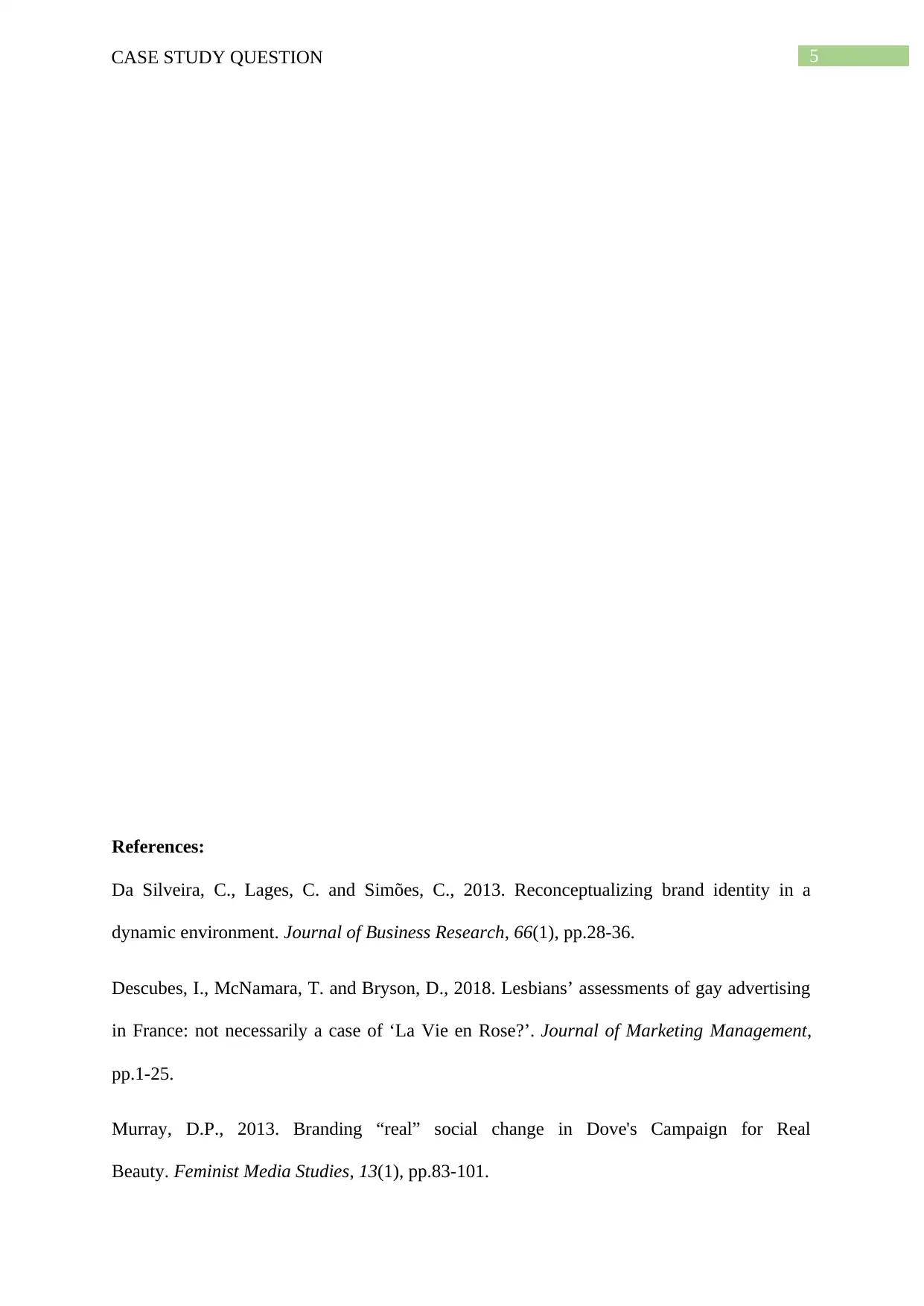
5CASE STUDY QUESTION
References:
Da Silveira, C., Lages, C. and Simões, C., 2013. Reconceptualizing brand identity in a
dynamic environment. Journal of Business Research, 66(1), pp.28-36.
Descubes, I., McNamara, T. and Bryson, D., 2018. Lesbians’ assessments of gay advertising
in France: not necessarily a case of ‘La Vie en Rose?’. Journal of Marketing Management,
pp.1-25.
Murray, D.P., 2013. Branding “real” social change in Dove's Campaign for Real
Beauty. Feminist Media Studies, 13(1), pp.83-101.
References:
Da Silveira, C., Lages, C. and Simões, C., 2013. Reconceptualizing brand identity in a
dynamic environment. Journal of Business Research, 66(1), pp.28-36.
Descubes, I., McNamara, T. and Bryson, D., 2018. Lesbians’ assessments of gay advertising
in France: not necessarily a case of ‘La Vie en Rose?’. Journal of Marketing Management,
pp.1-25.
Murray, D.P., 2013. Branding “real” social change in Dove's Campaign for Real
Beauty. Feminist Media Studies, 13(1), pp.83-101.
⊘ This is a preview!⊘
Do you want full access?
Subscribe today to unlock all pages.

Trusted by 1+ million students worldwide
1 out of 6
Related Documents
Your All-in-One AI-Powered Toolkit for Academic Success.
+13062052269
info@desklib.com
Available 24*7 on WhatsApp / Email
![[object Object]](/_next/static/media/star-bottom.7253800d.svg)
Unlock your academic potential
Copyright © 2020–2025 A2Z Services. All Rights Reserved. Developed and managed by ZUCOL.





